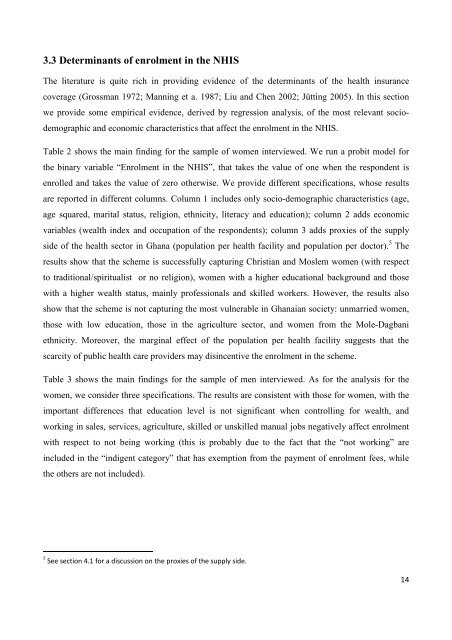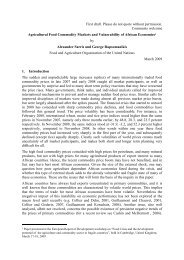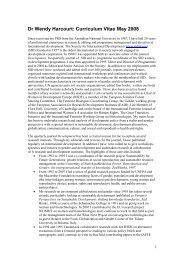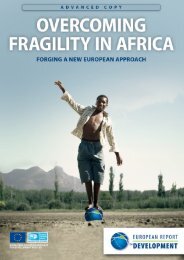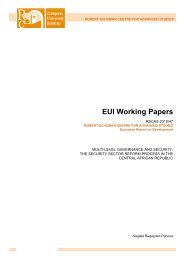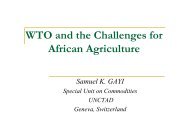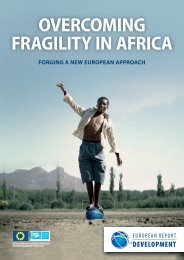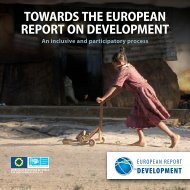Extending Health Insurance: Effects of the National ... - ResearchGate
Extending Health Insurance: Effects of the National ... - ResearchGate
Extending Health Insurance: Effects of the National ... - ResearchGate
Create successful ePaper yourself
Turn your PDF publications into a flip-book with our unique Google optimized e-Paper software.
3.3 Determinants <strong>of</strong> enrolment in <strong>the</strong> NHIS<br />
The literature is quite rich in providing evidence <strong>of</strong> <strong>the</strong> determinants <strong>of</strong> <strong>the</strong> health insurance<br />
coverage (Grossman 1972; Manning et a. 1987; Liu and Chen 2002; Jütting 2005). In this section<br />
we provide some empirical evidence, derived by regression analysis, <strong>of</strong> <strong>the</strong> most relevant sociodemographic<br />
and economic characteristics that affect <strong>the</strong> enrolment in <strong>the</strong> NHIS.<br />
Table 2 shows <strong>the</strong> main finding for <strong>the</strong> sample <strong>of</strong> women interviewed. We run a probit model for<br />
<strong>the</strong> binary variable “Enrolment in <strong>the</strong> NHIS”, that takes <strong>the</strong> value <strong>of</strong> one when <strong>the</strong> respondent is<br />
enrolled and takes <strong>the</strong> value <strong>of</strong> zero o<strong>the</strong>rwise. We provide different specifications, whose results<br />
are reported in different columns. Column 1 includes only socio-demographic characteristics (age,<br />
age squared, marital status, religion, ethnicity, literacy and education); column 2 adds economic<br />
variables (wealth index and occupation <strong>of</strong> <strong>the</strong> respondents); column 3 adds proxies <strong>of</strong> <strong>the</strong> supply<br />
side <strong>of</strong> <strong>the</strong> health sector in Ghana (population per health facility and population per doctor). 5 The<br />
results show that <strong>the</strong> scheme is successfully capturing Christian and Moslem women (with respect<br />
to traditional/spiritualist or no religion), women with a higher educational background and those<br />
with a higher wealth status, mainly pr<strong>of</strong>essionals and skilled workers. However, <strong>the</strong> results also<br />
show that <strong>the</strong> scheme is not capturing <strong>the</strong> most vulnerable in Ghanaian society: unmarried women,<br />
those with low education, those in <strong>the</strong> agriculture sector, and women from <strong>the</strong> Mole-Dagbani<br />
ethnicity. Moreover, <strong>the</strong> marginal effect <strong>of</strong> <strong>the</strong> population per health facility suggests that <strong>the</strong><br />
scarcity <strong>of</strong> public health care providers may disincentive <strong>the</strong> enrolment in <strong>the</strong> scheme.<br />
Table 3 shows <strong>the</strong> main findings for <strong>the</strong> sample <strong>of</strong> men interviewed. As for <strong>the</strong> analysis for <strong>the</strong><br />
women, we consider three specifications. The results are consistent with those for women, with <strong>the</strong><br />
important differences that education level is not significant when controlling for wealth, and<br />
working in sales, services, agriculture, skilled or unskilled manual jobs negatively affect enrolment<br />
with respect to not being working (this is probably due to <strong>the</strong> fact that <strong>the</strong> “not working” are<br />
included in <strong>the</strong> “indigent category” that has exemption from <strong>the</strong> payment <strong>of</strong> enrolment fees, while<br />
<strong>the</strong> o<strong>the</strong>rs are not included).<br />
5 See section 4.1 for a discussion on <strong>the</strong> proxies <strong>of</strong> <strong>the</strong> supply side.<br />
14


